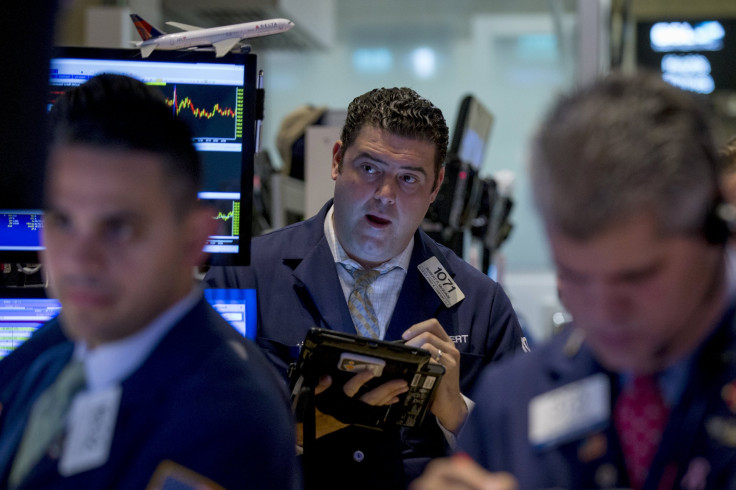Dow Jones Industrial Average Fluctuates As Muted Consumer Prices Complicate Federal Reserve Decision

This story was updated at 4 p.m. EDT
U.S. stocks closed higher Wednesday, with the Dow Jones Industrial Average up 140 points after fluctuating in morning trading amid consumer prices posting their first decline in seven months. However, energy stocks received a boost in afternoon trading after U.S. oil prices leaped nearly 6 percent as crude oil inventories unexpectedly fell.
The weaker-than-expected consumer price inflation data comes at a crucial time as the U.S. Federal Reserve kicked off its highly anticipated two-day meeting Wednesday, where Janet Yellen and policymakers will debate whether to raise interest rates, which would be the first increase in nearly a decade.
“In light of the heightened market uncertainty, strong U.S. dollar and worries about the slowdown in China and emerging markets, we believe the Fed will delay its rate hike decision to December,” Gregory Daco, chief U.S. economist at Oxford Economics, said in a research note Wednesday.
The Dow Jones Industrial Average (INDEXDJX:.DJI) rose 140.10 points, or 0.8 percent, to close at 16,739.95. The Standard & Poor's 500 index (INDEXSP:.INX) edged up 17.22 points, or 0.87 percent, to end at 1,995.31. The Nasdaq composite (INDEXNASDAQ:.IXIC) added 28.72 points, or 0.59 percent, to finish at 4,889.24.
Nine of the 10 S&P 500 sectors traded higher, led by a 2.7 percent gains in energy stocks after U.S. oil prices leaped around 6 percent. Telecom stocks were the only decliner, down just 0.2 percent.
Crude prices received a boost after U.S. oil inventories unexpectedly fell, declining by 2.1 million barrels in the last week, the U.S. Energy Information Administration said Wednesday. Following the report, West Texas Intermediate crude, the benchmark for U.S. oil prices, rose 5.7 percent to $47.15 per barrel for October delivery on the New York Mercantile Exchange. On the London ICE Futures Exchange, Brent crude closed at $50 a barrel.
Dow component General Electric Company (NYSE:GE) led the index higher, gaining 2.5 percent, while oil giants Chevron Corporation (NYSE:CVX) and Exxon Mobil Corporation (NYSE:XOM) rose 2.4 percent and 2 percent, respectively.
Economists are preparing for the Fed’s two-day policy meeting, which kicks off Wednesday, followed by a statement from the Federal Open Market Committee at 2 p.m. EDT Thursday. Fed Chair Janet Yellen will hold a press conference at 2:30 p.m. Thursday following that statement, and investors will look for clues to the timing of the Fed’s rate hike.
The financial markets are currently pricing in only about a 30 percent chance of a rate hike in September, says Daco. Economists, however, are almost evenly split about the prospects of a U.S. rate hike this week, with the Bloomberg consensus poll showing 39 economists looking for no change in the federal funds rate, while 41 are looking for a hike of 25 basis points, or a quarter of a percent.
U.S. consumer prices unexpectedly fell in August, marking the first decline since January. The drop signals muted inflation, which complicates the Federal Reserve's decision on whether to hike interest rates this week. The Consumer Price Index fell 0.1 percent last month after edging up 0.1 percent in July, the Labor Department said Wednesday.
Inflation has been held down by two key issues: the strong U.S. dollar and the precipitous drop in energy prices over the last year.
The decline in headline CPI inflation in August was partly due to the renewed decline in gasoline prices. Excluding food and energy, core consumer prices increased 0.1 percent in August, which was a little weaker than what economists were expecting. Part of the weakness was due to another weak reading for medical care prices, which were unchanged last month.
The central bank has a target for 2 percent annual inflation, using the personal consumption expenditures price index, which tends to run below the CPI.
Experts, however, expect the deflationary pressures from low energy prices and a strong dollar will begin to fade early next year. “Together with the fact that the economy is already very close to full employment, this suggests that both wages and core inflation will surprise on the upside next year,” Steve Murphy, U.S. economist at Capital Economics, said in a note.
Some experts argue Thursday's mixed CPI report is unlikely to have much of an impact on the Federal Open Market Committee's decision this week.
"With continued solid improvement in the labor market and inflation set to accelerate, PNC expects the FOMC to raise the fed funds target rate to a range of 0.25 to 0.50 percent when the committee releases its policy statement tomorrow afternoon at 2, although it remains a close call," Stuart Hoffman, chief economist at PNC Financial Services Group, said in a note.
Global shares traded higher ahead of the central bank’s meeting, with China’s benchmark Shanghai Composite index finishing up nearly 5 percent, while Japan’s Nikkei index closed up 0.8 percent.
European stocks traded higher, with Germany's DAX and France's CAC up 0.6 percent and 1.5 percent, respectively.
© Copyright IBTimes 2024. All rights reserved.












